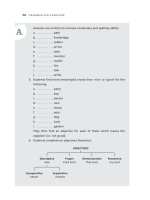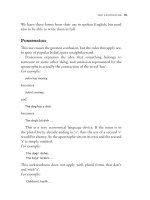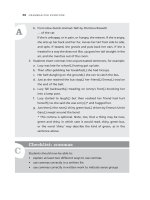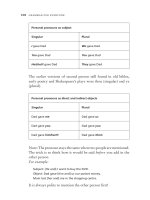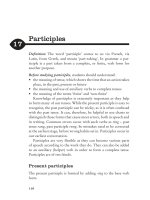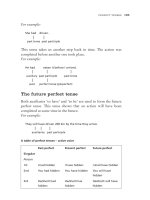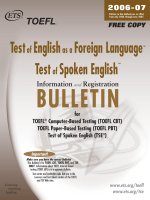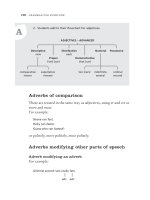Tài liệu Grammar for everyone part 21 doc
Bạn đang xem bản rút gọn của tài liệu. Xem và tải ngay bản đầy đủ của tài liệu tại đây (122.17 KB, 7 trang )
A
2. Students add to their flowchart for adjectives.
Adverbs of comparison
These are treated in the same way as adjectives, using er and est or
more and most.
For example:
Shane ran fast.
Ricky ran faster.
Guess who ran fastest?
or politely, more politely, most politely.
Adverbs modifying other parts of speech
Adverb modifying an adverb
For example:
Gilchrist scored runs really fast.
adv adv
130
G r A M M A r f o r e V e rY o n e
ADJECTIVES – ADVANCED
Descriptive
new
Proper
Ford (car)
PossessiveDistributive
each
Demonstrative
that (car)
Numeral
indefinite
several
ten (cars) ordinal
second
comparative
newer
superlative
newest
A
We clapped him very loudly.
adv adv
Adverb modifying an adjective
For example:
He was so pleased.
adv adj
Adverbs formed from adjectives
For example:
My shoelace is loose. [adj]
I tied it too loosely. [adv]
19.2 Activity: adjectives and adverbs
Students form adjectives and adverbs using the given nouns, for
example:
Noun Adjective Adverb
hope hopeless hopelessly
speed
pain
waste
fool
131
M o r e A b o u t A d j e c t i V e s A n d A d V e r b s
More punctuation
Before studying more punctuation, check that students can
recognise, understand and use correctly the following punctuation
marks: full stop, question mark, exclamation mark, comma,
inverted commas and apostrophe.
So far, the exercises have been mainly straightforward and
not purposely complex, as they are designed to test the students’
learning and assess the efficacy of the instruction.
Inevitably the students will come across variations in sentence
structure that test their skills and sometimes ours as well. In gen-
eral, unless they are unreasonably intricate or complex – in which
case we may leave them to grammarians to unravel – they can be
analysed by logic. Before we embark on studying more complex
but well-constructed sentences there are a few gaps to fill. So, in
this section, we uncover some of the classifications that further
clarify the terms we have been using and are now familiar with.
Firstly, we look at the remaining punctuation marks, under-
standing of which will enable students to reach a higher level of
maturity in their own composition.
Colons
Definition: The word is from Greek, kolon, meaning ‘a limb’ and
is used to indicate that some connected information is to follow.
• The colon’s most common use is to precede a list, especially of
items consisting of more than one word (note its use after ‘for
example’).
20
132
For example:
Here are some of the things you can do at our zoo: get close to
wild animals, feed the monkeys, cuddle a koala and observe a
platypus.
• The colon can provide a stop (or a short pause) between two
balanced parts of a sentence, in which the second part explains
or furthers the information given in the first part.
For example:
I got our tickets for the final: they had nearly sold out.
Note, too, how the use of the colon can make the narrative more
dramatic than when it is expressed in an ordinary sentence.
For example:
He ran to the opening: it was blocked by a fallen rock.
Compare with:
He ran to the opening, but found it was blocked by a fallen rock.
• Colons are used to introduce quotations.
For example:
Shakespeare’s ‘Julius Caesar’ opens with the words: ‘Hence! Home,
you idle Creatures, get you home.’
• This use of the colon would be one with which every modern
child would be familiar! That which separates parts of numerals,
as in time:
6:30 9:00
and in some digital time-pieces, one dot refers to a.m. and two
dots to p.m.
133
M o r e p u n c t u At i o n
A
20.1 Activities: colons
1. Students write an advertisement for the things you can do at:
a. a fun park
b. Underwater World
c. a museum
2. Students answer time questions with digital numerals.
a. When did you get up this morning?
b. What time do you start school?
c. When do you have lunch?
3.
Students use colons to write these sentences in a more dramatic way.
a. He got badly hurt when he fell off his skateboard.
b. We couldn’t get in because Emma had gone off with the key.
c. A green ant bit me, so I screamed.
Note: It may be more effective to change around the order of
words.
4. Students find a quotation from one of their books and introduce it,
mentioning the speaker. See the example from Shakespeare on the
previous page
.
Semicolons
Margaret Fullerton, in ‘Summer On The Lakes’ 1844, likened semi-
colons to the stops in a paragraph of thoughts about one’s life.
This is probably a very good description, as semicolons provide
a pause between connected thoughts and lie somewhere between
commas and full stops. For the more mature writer, semicolons are
very effective because they suggest a balance, but to avoid misuse
and confusion, it is wise not to introduce semicolons too early.
Perhaps the best way to describe semicolons is to say that they
link associated thoughts or statements.
For example:
The mantis rested on a green leaf; you might never notice it there.
He had no food; nor did he have any money.
134
G r A M M A r f o r e V e rY o n e
